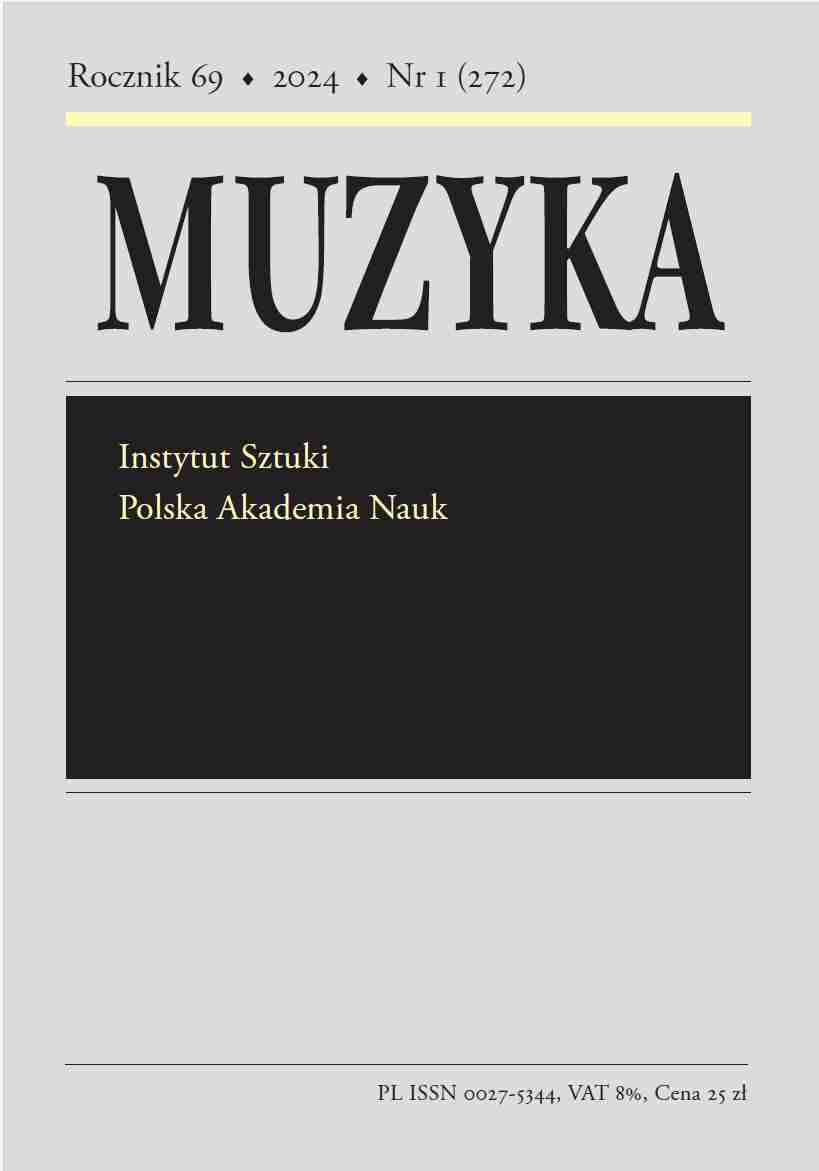The Morphology of 'Polish Rhythms' in Oskar Kolberg’s 'Mazowsze Polne', in the Light of Research Using Music Information Retrieval
Ewa Dahlig-Turek
Institute of Art, Polish Academy of Sciences (Poland)
https://orcid.org/0000-0003-1895-8594
Abstract
The aim of this paper is to present the results of research into ‘Polish rhythms’, that is, triple-time ‘descending’ rhythms, in traditional music from volumes 24 and 25 (Mazowsze Polne [‘Field’ Mazovia]) of Oskar Kolberg’s Dzieła Wszystkie (Complete works). Research into part of that material, confined to mazurka rhythms, with up to four or five syllables per measure, was carried out in 1959–60 by Jan Stęszewski (cf. ‘Morfologia rytmów mazurkowych na Mazowszu Polnym. Studium analityczne’ [The morphology of mazurka rhythms in ‘field’ Mazovia: an analytic study], part I Muzyka 4/4 (1959), pp. 147–159; part II Muzyka 5/2 (1960), pp. 29–53). That excellent study, based on analysis of song material, presents a comprehensive overview of mazurka rhythms in relation to the texts’ metrical structure. However, the limitations of manual data processing meant that the research was only applicable to that particular set of data; a different subject would require preparing the material from scratch.
Modern methods of analysing and processing collections using digital technology (Music Information Retrieval) open up broad perspectives for working on large repositories of material. Hence the second aim of this paper is to give representative examples of the use of the WebEsAC application, designed for working with the EsAC (Essener Assoziativ Code) in which all the works contained in Kolberg’s regional monographs have been transcribed (a project financed by the grant ‘Preparing music records from Oskar Kolberg’s Collected Works in Music Information Retrieval mode and making them available for scientific research’, no. 0238/NPRH4/H1a/83/2015). WebEsAC-based statistics of ‘Polish rhythms’ in Kolberg’s Mazowsze Polne complement the picture of triple-time rhythms in that region presented by Jan Stęszewski, and at the same time foreshadow future research, which, if applied to Kolberg’s entire collection, will make it possible to map the rhythmic properties of Polish musical folklore.
Thanks to the possibility of filtering and searching through the musical material, the WebEsAC app may prove to be a valuable tool not only for ethnomusicologists, but also for music historians studying references to traditional music in the output of selected composers.
Supporting Agencies
Keywords:
Oskar Kolberg, mazurka rhythms, Polish rhythms, digital rhythm analysis, Music Information RetrievalReferences
Bielawski, Ludwik. Rytmika polskich pieśni ludowych. Kraków: PWM, 1970.
Google Scholar
Dahlig, Ewa. „Możliwości muzycznych baz danych w Instytucie Sztuki PAN ”. W: Muzykologia u progu trzeciego tysiąclecia. Teoria i praktyka, red. Ludwik Bielawski, Katarzyna Dadak-Kozicka, Agnieszka Leszczyńska, 243–253. Warszawa: Akademia Muzyczna im. F. Chopina, 2000.
Google Scholar
Dahlig-Turek, Ewa. Rytmy polskie w muzyce XVI–XIX wieku. Studium morfologiczne. Warszawa: Instytut Sztuki PAN , 2006.
Google Scholar
Dahlig-Turek, Ewa. „Music Information Retrieval we współczesnych badaniach nad muzyką ludową”. Muzyka 59, nr 3 (2014): 167–174.
Google Scholar
Kolberg, Oskar. Dzieła Wszystkie. T. 18‒19, Kieleckie. Wrocław–Poznań: PWM, 1963.
Google Scholar
Kolberg, Oskar. Mazowsze. Obraz etnograficzny. T. 1–2, Mazowsze Polne. Kraków: Zapomoga Kasy im. J. Mianowskiego [W.L. Anczyc], 1885–1886.
Google Scholar
Kolberg, Oskar. Dzieła Wszystkie. T. 24–25, Mazowsze. Wrocław–Poznań: PWM, 1963.
Google Scholar
Stęszewski, Jan. „Morfologia rytmów mazurkowych na Mazowszu Polnym. Studium analityczne”. Muzyka 4, nr 4 (1959): 147–159; Muzyka 5, nr 2 (1960): 29–53.
Google Scholar
Authors
Ewa Dahlig-TurekInstitute of Art, Polish Academy of Sciences Poland
https://orcid.org/0000-0003-1895-8594
Statistics
Abstract views: 491PDF downloads: 347
License
Copyright (c) 2021 Ewa Dahlig-Turek

This work is licensed under a Creative Commons Attribution-NonCommercial-NoDerivatives 4.0 International License.
The author grants the publisher a royalty-free nonexclusive licence (CC BY 4.0) to use the article in Muzyka, retains full copyright, and agrees to identify the work as first having been published in "Muzyka" should it be published or used again (download licence agreement). By submitting an article the author agrees to make it available under CC BY 4.0 license.
Articles from 2018/1 to 2022/3 were published under a Creative Commons license CC BY-NC-ND 4.0. During this period the authors granted the publisher a royalty-free nonexclusive license (CC BY-ND 4.0) to use their article in "Muzyka", retained full copyright, and agreed to identify the work as first having been published in our journal should it be published or used again.










